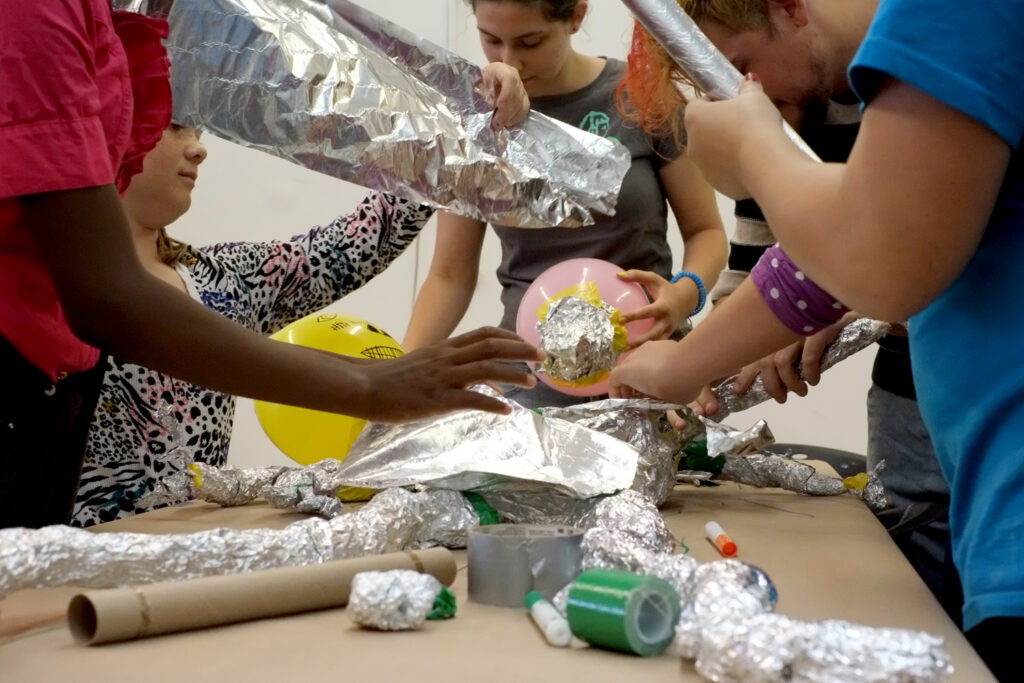When you think about youth arts education, traditional images of high school art classrooms might come to mind: textbooks, sketchbooks, acrylic paints. But not in Pittsburgh. Artists and educators, like those from Pittsburgh Filmmakers, are using digital technologies to help reimagine arts education and make it more participatory.
“We’re using film to engage teens in critical thinking and to let them explore a more tangible form of science and art,” said Pittsburgh Filmmaker mentor Marie Mashyna. She and her colleagues work with organizers from the Pittsburgh Center for the Arts to teach youth how to hand-process Super 8 film and shoot their own movies, all within the walls of the Carnegie Library. They’ve been teaching filmmaking workshops for teens this summer through The Labs @ CLP, a digital space for teens at the library.
The classes rely on a number of digital tools, and emphasize the relationship between technology and art. “Learning about film helps them understand the current digital world more,” Mashyna said in a recent blog post about the project.
The Pittsburgh Filmmakers’ collaboration is just one example of how educators are working to make the arts a part of students’ everyday lives while incorporating technology into the process. At a time when arts education is often the most expendable aspect of a curriculum for schools facing financial crisis and budget cuts, more and more educators and policy makers are realizing its importance.
A new report by Indiana University researcher Kylie Peppler finds that despite cuts in arts education programs in schools, a strikingly different landscape exists among arts education programs that take place outside of school, where technology is effectively used to engage students’ artistic creativity. “What makes this landscape possible is an eagerness to explore that springs from youths’ own creative passions—what we call ‘interest-driven arts learning’—combined with the power of digital technology,” Peppler wrote in the report.
The study took a look at the technology-based arts learning in small communities, using case studies and examples from across the country. Take participatory digital games like Rock Band and Guitar Hero, for example. Peppler cited a 2010 study that found extended play in such music-themed action games, which require players to press buttons in a sequence dictated along with a soundtrack, positively correlated with the assessment of youths’ traditional music abilities. “Stepping into the shoes of the onscreen musicians motivates youths to learn the real skills that will enable them to play independently,” Peppler wrote.
She asked one 11-year-old boy why he chose to sign up for violin lessons after playing Rock Band at an afterschool club and he responded, “I want to learn guitar, and if I can do this (mimics the playing of a violin), then I can do this (mimics the playing of a guitar).”
The report also said that new technologies have made it easier for youth to collaborate, share, and publish their work, providing more pathways for them to engage with the arts and their peers. While Facebook and Twitter are obvious examples, Peppler also cited Remix Learning, a customizable, cloud-based social learning network that can be implemented in schools and afterschool programs.
The platform, developed out of Chicago’s Digital Youth Network, allows users to post graphic designs, games, and videos, as well as exchange ideas and critique their peers’ work. Online mentors trained and paid for through the Digital Youth Network encourage young people to post their work. Mentors then model that behavior by posting their own creative endeavors and moderating online discussions and competitions. An incentive system awards youth for continuous and effective participation.
Peppler’s research ultimately advocated for the integration of this technology-based, interest-driven excitement into formal learning environments. “In the perfect landscape, we see better coordination between schools and non-traditional forms because there is so much untapped potential,” said Peppler in a recent Education Week blog post. “So many kids are exploring art on their own, and schools will hopefully find a way to support that learning.”
Peppler does not give specifics on how to integrate these interest-driven arts communities into schools. But here in Pittsburgh, educators are figuring this out.
With support from the Allegheny Intermediate Unit [AIU], schools in the region are marrying arts with science, technology, engineering, and math (STEAM). New projects are cropping up at area schools like the library at Elizabeth Forward High School outside of Pittsburgh, where students perform and record original compositions. At the Crafton Elementary STEAM studio, students are encouraged to take charge of their own learning by doing everything from building K’NEX Ferris wheels and roller coasters to controlling robotic devices using computer software.
The region’s new Hive Learning Network aims to create a more seamless ecosystem of learning opportunities for kids, including opportunities to work on arts-based projects both in and outside school.
At Avonworth High School in Pittsburgh, students will work with professional artists at five local institutions: The Andy Warhol Museum, Carnegie Museum of Art, Mattress Factory, Pittsburgh Glass Center, and Toonseum of Pittsburgh. The students will team up to learn more about the art world and blog about the experience.
“Often, kids who are interested in the arts might not know what their career options are,” Avonworth studio art teacher Kerri Villani told the Pittsburgh Post Gazette. “I want the students to learn how to be the curator, not just the artist. I want them to see what else they can do inside the museum.”
